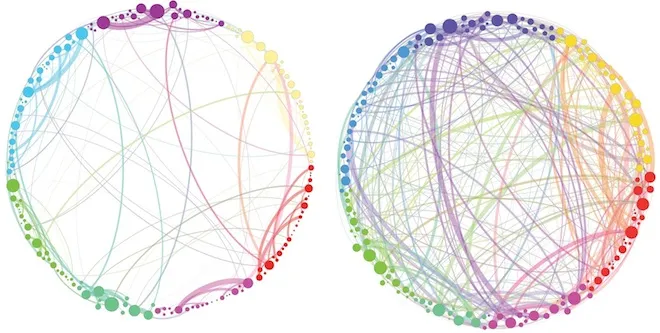Psilocybin and Human Evolution–an Introduction
Human evolution is a complex process influenced by various factors. While traditional theories have emphasised physical adaptations and environmental pressures, emerging research suggests that ingesting psychedelics, particularly psilocybin-containing mushrooms, may have shaped our evolutionary trajectory.
This article touches on the hypothesis that the consumption of psychedelic mushrooms
influenced the evolution of humans, contributing to the development of unique cognitive, communicative, and cooperative patterns in human populations.
By Alexandra Plesner
Early Hominins and Mushroom Consumption
Evidence suggests that early hominins, including australopithecines and early Homo, were omnivores who relied heavily on forest floor foods, including mushrooms. Mycophagy and self-medication in primates and Paleolithic humans imply that hominins also incorporated fungi with bioactive properties into their diet. It is possible that psychedelic mushrooms from the genus Psilocybe were ingested by our ancestors, particularly during the Pliocene and Pleistocene eras, when hominins intensified foraging activity on the ground.
The Availability of Psilocybin-Containing Mushrooms
Psilocybin-containing mushrooms are found on all continents (except maybe Antarctica) and across various ecological zones. They actually thrive in landscapes affected by human activities, such as woodland clearings and grazing pastures. This widespread availability suggests that these mushrooms were readily accessible to early humans as they spread across Africa, Eurasia, and eventually the globe.
The Stoned Ape Theory
The Stoned Ape theory, proposed by ethnobotanist and mystic Terence McKenna, offers exactly that thought-provoking perspective on the evolution of humanity in his 1992 book “Food of the Gods”. According to this theory, early human ancestors may have experienced profound cognitive and evolutionary leaps by consuming psychedelic substances, particularly psilocybin mushrooms, during their evolutionary journey. McKenna hypothesised that ingesting these substances enhanced perception, creativity, problem-solving abilities, and social cohesion, contributing to human consciousness and cultural development. While the Stoned Ape theory remains speculative and lacks empirical evidence, it has sparked fascinating discussions about the potential role of psychedelic experiences in shaping human evolution and expanding human cognitive capabilities.
Communication between brain networks in people given psilocybin (right) or a non-psychedelic compound (left).PETRI ET AL./PROCEEDINGS OF THE ROYAL SOCIETY INTERFACE
Your Brain on Psilocybin
Psychedelics like psilocybin and LSD modify fundamental brain processes, including perception, emotion, cognition, and the sense of self. These effects primarily occur through the interaction with the serotonin (5-HT) system, specifically by binding to the 5-HT2A receptor as partial agonists. This interaction increases the excitability of neocortical pyramidal neurons, disrupting cortical rhythmicity and large-scale brain networks. The resulting changes in brain activity and connectivity lead to a flexible and functionally more connected brain during the psychedelic state.
The Impact on Human Evolution
This article proposes that psychedelic consumption, particularly the incidental ingestion of psilocybin-containing mushrooms, could have directly influenced the adaptation of early humans to their environment. The effects of psilocybin on the 5-HT2A receptor-mediated active coping strategy may have provided elevated cortical plasticity, enhanced associative learning, and an increased capacity for psychological transformation. These effects would have contributed to developing socio-cognitive abilities crucial for survival and success in highly socially cooperative communities.
The emergence of distinctively human capabilities, such as collective intentionality, hyper-cooperation, cultural transmission, and innovation, occurred throughout our evolutionary history. These capabilities were facilitated by a pattern of socio-cognitive niche construction, characterised by cumulative culture and substantial neurological and behavioural plasticity. In this context, the ingestion of psychedelics, including psilocybin, may have played a role in enhancing adaptability and fitness, further promoting the development of women's cognitive and cooperative abilities.
The Institutionalisation of Psychedelic Consumption
Over time, psychedelic consumption became institutionalised in many pre-modern human societies through rituals focused on healing, divination, and socialisation. While predominantly consumed by male shamans, psychedelics were also consumed by the general population in some cultures. Hunters and gatherers likely learned about hallucinogenic plants as part of their detailed environmental understanding. The cultural value placed on personal revelations induced by psychedelics is evident in the recurring mythological roles attributed to these mind-altering substances.
Conclusion
While the influence of psychedelics on human evolution, including women's development, is a compelling hypothesis, it requires further empirical examination. Cross-cultural research methods and experimental approaches can help elucidate the relationship between psychedelics and human cognition, communication, and the evolution of cooperation. By integrating anthropological and neuropsychopharmacological knowledge, we can deepen our understanding of how psychedelics potentially shaped our evolutionary path.
The ingestion of psychedelic mushrooms, specifically those containing psilocybin, is proposed to have directly affected the adaptation and evolution of early humans, including women. By enhancing cognitive and cooperative abilities, psychedelics may have contributed to developing unique socio-cognitive patterns in human populations. Further exploration and empirical testing are necessary to understand the role of psychedelics in human evolution fully and appreciate the intricate interplay between these substances and our species' development.




